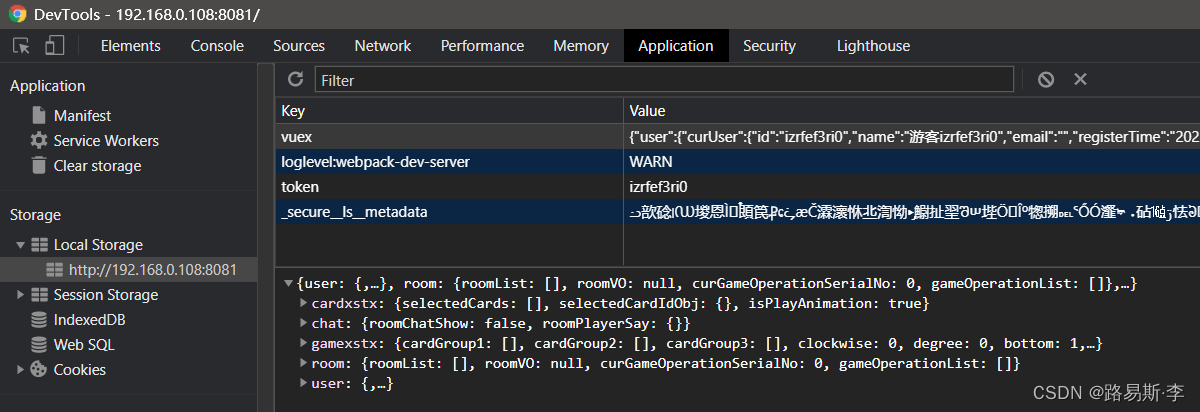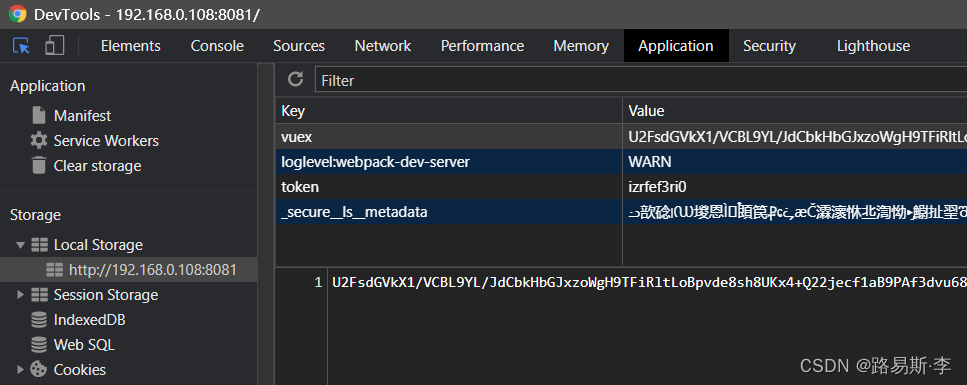【前端】Vuex模块化和持久化应用示例
1. 概述
Vuex作为VUE状态管理组件,能够将项目中公共数据状态进行统一管理,并且可以按照不同的业务功能将数据状态分模块管理,即数据状态模块化。
另外,对于网页刷新导致Vuex状态丢失的问题可以使用vuex-persistedstate插件配置将数据保存在localStorage或者sessionStorage中,即数据状态持久化。
同时使用secure-ls插件将明文数据加密,以防数据泄露风险。
本文测试环境如下:
Node版本:v10.14.2
Npm版本:6.4.1
package.json依赖的插件版本如下:
“vue”: “^2.2.37”,
“vue-router”: “^3.0.1”,
“vuex”: “^3.0”,
“vuex-persistedstate”: “^4.1.0”
“secure-ls”: “^1.2.6”,
2. Vuex的模块化
Vuex的模块化将按照顺序分为3个部分:Vuex组件实例化与引用、子模块的创建、模块化的使用方法。
2.1 Vuex组件实例化与引用
首先创建Vuex状态实例文件src/store/index.js,用于创建状态实例,并将根状态的四个参数(state, getters, mutations, actions),以及各个模块实例添加到modules对象参数中。详见以下代码。
// src/store/index.js
import Vue from 'vue'
import Vuex from 'vuex'
import user from "./modules/user";
import room from "./modules/room"// 使用Vuex组件
Vue.use(Vuex)
const state = () => ({})
const getters = {}
const mutations = {}
const actions = {}// 实例化状态对象
export default new Vuex.Store({// 根模块的四类对象state, getters, mutations, actions,modules: { // 将各个模块放入modules属性中user, room}
})
至于以上代码中引入的user,room子模块,下文将进行介绍。
接下来要将Vuex组件实例添加到Vue实例中,具体操作见如下代码。
// src/main.js
import Vue from 'vue'
import store from "./store";
/* eslint-disable no-new */
new Vue({el: '#app',router,store,components: { App },template: '2.2 子模块的创建
上文.src/store/index.js文件中,有user和room2个模块,模块之间大同小异,下面主要以user子模块进行讲解。本节主要介绍子模块的创建,具体使用方法将在2.3节有详细介绍。
// src/store/modules/user.js
// user子模块
const state = () => ({}) // 详见2.2.1小节
const getters = {} // 详见2.2.2小节
const actions = {} // 详见2.2.3小节
const mutations = {} // 详见2.2.4小节
export default {namespaced: true,state,getters,mutations,actions
}
2.2.1 state,数据状态对象
state作为数据状态的存储,是一个匿名函数返回的对象。
如下代码所示,该对象中两个数据状态curTheme和curUser,其中curTheme是字符串类型,curUser是对象类型。
// src/store/modules/user.js
// state: 用户相关状态
const state = () => ({curTheme: 'light',curUser: {id: '123456',name: '张三'}
})
2.2.2 getters,计算属性对象
getters作为计算属性,类似vue组件中的computed属性。
如下代码所示,该对象中是一个个的方法函数,该函数按照顺序有(state, getters, rootState, rootGetters)四个参数。
// src/store/modules/user.js
const getters = {// 获取当前用户ID curUserId: (state, getters, rootState, rootGetters) => {return state.curUser ? state.curUser.id : undefined},// 比对userId是否是当前用户idisCurUserId: (state, getters, rootState, rootGetters) => {return (userId) => {return userId == getters.curUserId;}},// 根据userId获取当前主题getCurThemeByUserId: (state, getters, rootState, rootGetters) => {return (userId) => {if(getters.isCurUserId(userId)) return state.curTheme;else return '';}}
}
其中,前两个参数state和getters是本模块中的数据状态对象(即2.2.1节中介绍的state对象)和计算属性对象(即本节介绍的getters对象),这两个参数是局部参数,只能访问本模块中的数据状态和计算属性对象。
后两个参数rootState和rootGetters可以用来访问根模块和其他子模块的数据状态和计算属性对象。
2.2.3 actions,异步请求对象
actions内部是也是一个个函数,主要用于执行异步请求逻辑。而且,如果需要更改数据状态,则必须通过commit调用相应的mutation对象。
另外,该函数有两个参数(context, payload),其中context是一个对象,即{state, rootState, commit, dispatch, getters, rootGetters}等6个参数(具体解释见如下代码中注释),palyload为调用时的自定义输入参数。
需要注意的是,actions中的
(context, payload)参数中context是对象,所以里面的参数可以是无序的。但是getters中的(state, getters, rootState, rootGetters)是四个参数,并且是有序的,千万注意顺序!!!
// src/store/modules/user.js
// actions,异步操作,通过mutation进行更新数据
const actions = {//context:{// state, 本模块数据状态对象,例如state.curTheme// rootState, 根模块数据状态对象,例如rootState.user.curTheme// commit, 用于调用mutation函数,例如commit('SET_CUR_USER', null)// dispatch, 用于调用action函数,例如dispatch('logout')// getters 本模块计算属性对象,例如getters.curUserId// rootGetters 根模块计算属性对象,例如rootGetters['user/curUserId']// }// 用户登录async login ({state, rootState, commit, dispatch, getters, rootGetters}, {name, passwd}) {// 用户登录逻辑let res = await $api.login();if(!res.success) Message.error('登录失败'); },// 登出async logout({commit}) {let res = await $api.logout()},
2.2.4 mutations,数据同步对象
mutations数据同步对象,内部是一个个同步函数,该函数没有返回值,内部逻辑主要是为了修改state属性。
注意千万不要在actions或者其他地方直接设置state数据状态。若要修改state状态,必须使用commit调用mutations函数,因为只有在mutations函数中修改才能触发Vuex数据和视图同步更新。
// src/store/modules/user.js
// mutations,定义更新数据方法,同步操作
const mutations = {SET_CUR_THEME (state, curTheme) {state.curTheme = curTheme},SET_CUR_USER (state, curUser) {// curUser是对象类型,需要使用Vue.set方法赋值,数组类型也一样需要Vue.set(state, 'curUser', curUser)},
}
2.3 模块化的使用方法
Vuex模块化后不仅可以在自定义组件中使用,而且可以引入store实例使用。
2.3.1 在自定义组件中使用
// RoomGaming.vue
...
2.3.2 引入store实例使用
不仅在自定义组件中使用,而且可以引入store实例在任何js文件中使用。使用方法如同自定义组件中的this.$store。
// ReceiveService.js
import $store from '../store'
const testFunction = (data) => {// mutations$store.commit("gamexstx/SET_CLOCKWISE", data.clockwise);$store.commit("gamexstx/SET_BOTTOM", data.bottom);$store.commit("gamexstx/SET_DEGREE", data.degree);$store.commit("gamexstx/SET_PLAYER_STATE", data.playerState);// getterslet index = $store.getters['gamexstx/curDrawIndex']let code = $store.getters['gamexstx/getCardInGroup1ByIndex'](index);// actionsawait $store.dispatch('cardxstx/playDrawCardAnim', {code, target});// stateif($store.state.gamexstx.degree > 0) return;
}3. Vuex持久化配置
在src/store/index.js中添加plugins属性,并设置key和storage属性,key是键名,storage是存储位置,可以是window.localStorage也可以是window.sessionStorage。
// src/store/index.js
import createPersistedState from 'vuex-persistedstate'export default new Vuex.Store({state,getters,mutations,actions,modules: {user, room, chat, gamexstx, cardxstx},plugins: [createPersistedState({key: 'vuex',storage: window.localStorage,})]
})因为localStorage不会随着网页刷新而丢失数据,所以将Vuex数据状态存储在此解决刷新丢失数据的问题。如下图,可以看到相应的数据存储。

另外,由于是明文存储,可能存在安全问题,可以使用secure-ls插件对数据进行加密存储。
// src/store/index.js
import SecureLS from "secure-ls"
var ls = new SecureLS({encodingType: "aes", //加密类型isCompression: false, //是否压缩encryptionSecret: "encryption", //PBKDF2值 加密秘密
});export default new Vuex.Store({state,getters,mutations,actions,modules: {user, room, chat, gamexstx, cardxstx},plugins: [createPersistedState({// 以下使用ls加密key: 'vuex',storage: {getItem: (key) => ls.get(key),setItem: (key, value) => ls.set(key, value),removeItem: (key) => ls.remove(key),}})]
})
加密之后,控制台显示如下,可以看到vuex中内容已加密。

项目传送门:https://github.com/louislee92/vue-module-persistedstate
